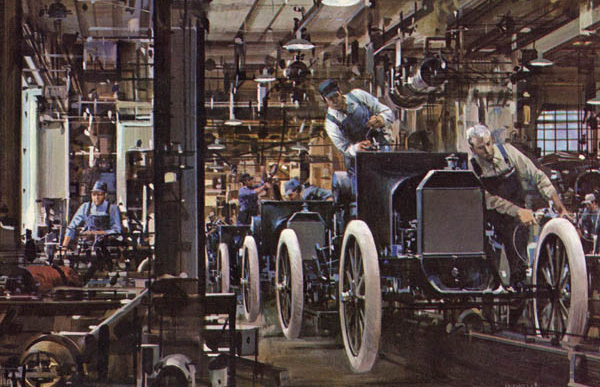Urban Mechanics vs. Rural Time Release


In his book One Dimensional Man, Herbert Marcuse speculated that for society to have “progress” (by which he meant egalitarian views) civilization had to rid itself of historical backwardness, or the bonds of the people themselves to their national product (via tradition and heritage). This would lead to the process of desublimation, or ‘the breakdown of socially acceptable behaviors to a more primitive, debased and individual response to society.’
These ideals have since been successfully industrialized, as all aspects of culture are now bent and broken to fit around the manufacturing values of planned obsolescence. The goalposts of ethics themselves are moved and altered where they grate up against this distribution power-structure. This has led to an urbanite quantitative preference towards art, music, fashion, architecture and all artifacts of culture which still survive in the rented spaces partitioned in the city. With this in mind, let us remember that before modern cities our artists painted sunsets and pastures, inspired by the potentials of the land and hearth-values of family.
Urban mechanics:
Due to the onslaught of the industrial revolution, manufacturing became a streamlined process, making it easier for people in population-dense areas to get what we sadly must call: affordable products. Comfort and luxury also became more accessible to greater numbers of people, or so we are informed by our progressive history. The capitalist model of technology and resource bequeathed us both this model of distribution Industrialization as well as the modern decadence which follows it.

Artists like Edgar Degas, a painter born into wealth, took his inspiration from depicting prostitutes at the bathhouses and midnight cabarets. His art style became increasingly more abstract as the years went on due to industrialized sentiment towards ‘historical backwardness’ which blossomed in the cities. As items became quicker to manufacture so did art, and along with that came the replacement of healthy art concepts for merely new ones, brought on by the now open rebellion against realism and objective beauty. Henri de TaLouse Latrec was another urban artist in the vein of Degas. However LaTrec truly outdid Degas in the Modernism race by being known for sleeping with his prostitute subjects and dying of alchoholism and Syphilis. LaTrec made it a point to draw out the ugliness in his subjects as a reflection of himself and his deformities, but also to mirror the society that was being born around him through industrialization and decadence.
Rural means:
As urbanized mechanics consolidate habits in the city-sized Petri dishes around the world, the slower more sublimated culture continues unimpeded by Marcusean, anti-historical forwardness. Industrialization brought consumption of cheap oil-byproduct-materials – plastics, and pollutants. Formerly the artist and builder used natural resources to create work that eroded gracefully over time. William Turner and Claude Monet were enamored by the majesty of the rural landscape, even Salvador Dali would go on to paint the Catalan Coast in Spain, the landscape of his homeland. Of course as the artist moves from the country to the city for proximity to collectors and business, they inevitably become consumed by the mechanics of urbanization. Sadly this process eventually spreads back into rural society.

Rural Time Release:
Urbanized people often note how certain culture which is more prominent in the city takes time to catch-on in rural surroundings. This is usually perceived by urbanites as rural people being alienated from the mechanized-system-culture. For example; Jokes from movies or popular music from twenty years previous still get repeated by the rural class on their local radio stations. I would theorize that this subconscious behavior is at least partially a defense mechanism against the ceaseless addictive need for newness in trend seen among the urbanite. Also very little urban culture is created that speaks to the rural class at all. Twenty years is the time frame in which nostalgic culture in industrialized society returns in a sunsetting final effort to influence and be remembered, as the population has largely forgotten it’s passing and can feel a nostalgia towards it.
Unfortunately nostalgia is not enough to stop the process of trend, but a twenty year time-rift between popular city culture and rural culture is a rough rule. In the contemporary context, this cultural variable may also simply represent the last urban culture that rural people can relate to at all. Either way, this outlines the total absence of relatable art for fully half or more of the modern nation, and the easy contempt the urbanite holds for the rural, and the refusal to furnish them with the one and only truly worthwhile artifact of a city: high culture. This in and of itself is a division symptomatic of urbanized mechanics as an elite boutique clique that is inspired only by industrialized decadence. For one to seek to rectify this divide it is best to have knowledge of it, but also to fill the void with creation. Industrialization will not vanish on its own, but the assembly-line creation model does not need to make everything from plastic or everything overseas. The more art being made with natural value systems and historical consideration, the more urban cultural-machinists will have to reconsider their now almost totally artless ahistorical culture and and its accompanying cosmopolitan smugness.
Remember: rootlessness has no ground or soil. and the mechanics of urbanization is a reaction to the natural.













Great post. Describes well the power that lies in urbanization and the rural fetish for urban culture. Please check out our YouTube channel if you have the time, just search for YouTube + Lilou & John. As we are 50/50 urban/rural, progressive/reactionary, innovation/tradition, perhaps there is something you might like.